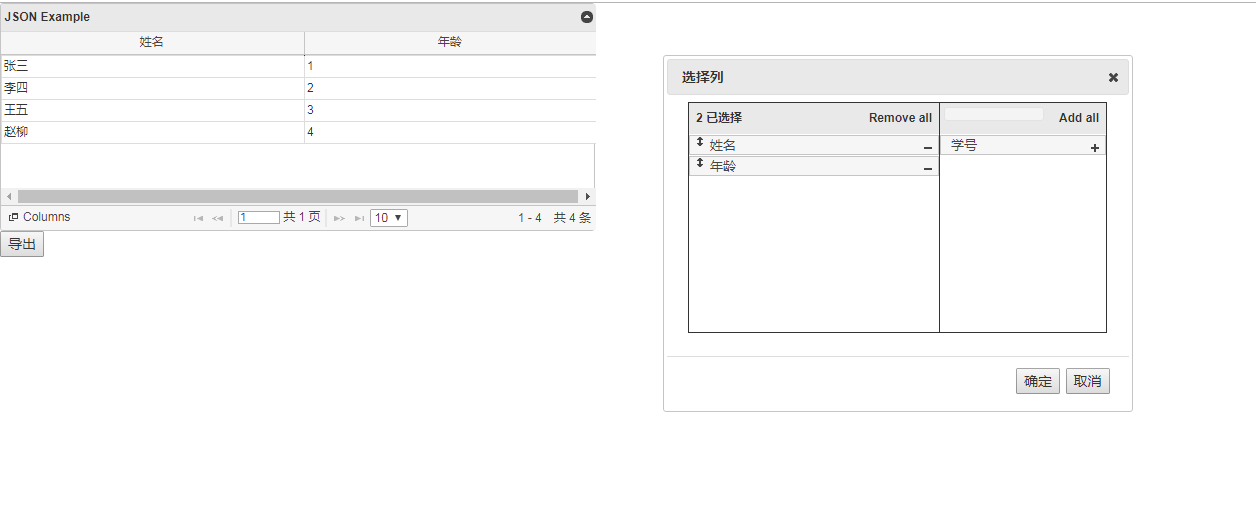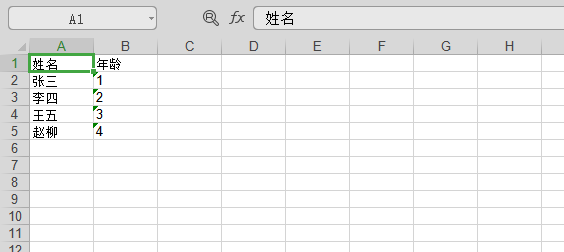通过之前讲过的jqGrid的columnChooser可以动态隐藏或者显示列,将显示列的列名和字段名传入后端,通过POI就可以实现自定义字段导出Excel
以下是js代码
$(function(){
//页面加载完成之后执行
pageInit();
});
function pageInit(){
//创建jqGrid组件
jQuery("#list2").jqGrid(
{
url : 'selectAll',//组件创建完成之后请求数据的url
datatype : "json",//请求数据返回的类型。可选json,xml,txt
colModel : [ //jqGrid每一列的配置信息。包括名字,索引,宽度,对齐方式.....
{label : '学号',name : 'id',width : 255},
{label : '姓名',name : 'name',width : 300},
{label : '年龄',name : 'age',width : 290},
],
rowNum : 10,//一页显示多少条
rowList : [ 10, 20, 30 ],//可供用户选择一页显示多少条
pager : '#pager2',//表格页脚的占位符(一般是div)的id
mtype : "post",//向后台请求数据的ajax的类型。可选post,get
viewrecords : true,
caption : "JSON Example"//表格的标题名字
});
$("#list2").jqGrid('navGrid','#pager2',{add:false,edit:false,del:false,search:false,refresh:false});
$("#list2").jqGrid('navButtonAdd','#pager2',{
caption: "Columns",
title: "Reorder Columns",
onClickButton : function (){
$("#list2").jqGrid('columnChooser');
}
});
}
$("#export").click(function () {
var columns = $("#list2").jqGrid("getGridParam","colModel");
var nameList = new Array();
var indexList = new Array();
columns.forEach(function (column) {
//将非隐藏的字段名和字段抽取出来
if(column.hidden == false){
nameList.push(column.label);
indexList.push(column.name);
}
})
//这里之所以用跳转是因为ajax不能进行下载,数组直接拼接
window.location.href = "export?indexList=" + indexList + "&nameList=" + nameList;
});
HTML代码就不贴了,在之前的博客中有现成的可以下载,放一张页面的效果图,隐藏一列

Controller端代码
public void export(HttpServletRequest request, HttpServletResponse response,String[]indexList,String[]nameList){
//获取数组
List<Person> list = userMapper.select();
//通过传入Class,列名以及字段名的数组得到service处理后的workbook
HSSFWorkbook workbook = exportService.getWorkbook(Person.class,nameList,indexList,list);
String fileName = "test.xls";
//xls对应的content-type
response.setContentType("application/x-xls");
//通知浏览器下载附件
response.setHeader("Content-Disposition","attachment;fileName=" + fileName);
OutputStream out = null;
try{
out = response.getOutputStream();
workbook.write(out);
}catch(Exception e){
e.printStackTrace();
}finally {
try {
out.flush();
out.close();
workbook.close();
} catch (IOException e) {
e.printStackTrace();
}
}
}
Service的处理代码
public HSSFWorkbook getWorkbook(Class cls , String[]nameList, String[] indexList, List<Person> persons){
HSSFWorkbook workbook = null;
try{
workbook = new HSSFWorkbook();
//生成一个sheet
HSSFSheet sheet = workbook.createSheet();
//创建第一行标题
Row row = sheet.createRow(0);
//根据传入的name创建cell并赋值
for(int i = 0; i < nameList.length; i++){
Cell c = row.createCell(i);
c.setCellValue(nameList[i]);
}
for(int i = 0; i < persons.size(); i++){
Person p = persons.get(i);
//第一行为标题,从第二行开始插入数据
row = sheet.createRow(i+1);
//遍历字段数组通过类的反射获取get方法得到数据
for(int j = 0; j < indexList.length; j++){
String methodName = "get" + indexList[j].substring(0,1).toUpperCase() + indexList[j].substring(1);
Method method = cls.getDeclaredMethod(methodName);
Object obj = method.invoke(p);
if(obj == null){
obj = "";
}
Cell c = row.createCell(j);
c.setCellValue(obj.toString());
}
}
}catch (Exception e){
e.printStackTrace();
}
return workbook;
}
生成的Excel预览

代码写的比较粗糙,service处理workbook那也只是写了一个大概,具体对值的处理以及cell样式也没有涉及。这里只是提供一个导出的思路供大家参考